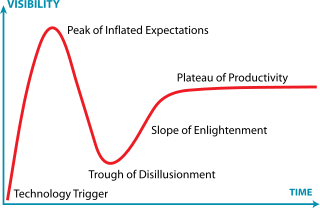Hype cycle

The hype cycle is a branded graphical presentation developed and used by American information technology (IT) research and advisory firm Gartner for representing the maturity, adoption and social application of specific technologies. The hype cycle provides a graphical and conceptual presentation of the maturity emerging technologies through five phases.
Five phases

Each hype cycle drills down into the five key phases of a technology's life cycle.
| No. | Phase | Description |
|---|---|---|
| 1 | Technology Trigger | A potential technology breakthrough kicks things off. Early proof-of-concept stories and media interest trigger significant publicity. Often no usable products exist and commercial viability is unproven. |
| 2 | Peak of Inflated Expectations | Early publicity produces a number of success stories—often accompanied by scores of failures. Some companies take action; most don't. |
| 3 | Trough of Disillusionment | Interest wanes as experiments and implementations fail to deliver. Producers of the technology shake out or fail. Investments continue only if the surviving providers improve their products to the satisfaction of early adopters. |
| 4 | Slope of Enlightenment | More instances of how the technology can benefit the enterprise start to crystallize and become more widely understood. Second- and third-generation products appear from technology providers. More enterprises fund pilots; conservative companies remain cautious. |
| 5 | Plateau of Productivity | Mainstream adoption starts to take off. Criteria for assessing provider viability are more clearly defined. The technology’s broad market applicability and relevance are clearly paying off. |
The term "hype cycle" and each of the associated phases are now used more broadly in the marketing of new technologies.
Hype in new media
Hype (in the more general media sense of the term "hype"[1]) plays a large part in the adoption of new media forms by society. Terry Flew states that hype (generally the enthusiastic and strong feeling around new forms of media and technology in which people expect everything will be modified for the better) surrounding new media technologies and their popularization, along with the development of the Internet, is a common characteristic. But following shortly after the period of 'inflated expectations', as per the diagram above, the new media technologies quickly fall into a period of disenchantment, which is the end of the primary, and strongest, phase of hype.
Many analyses of the Internet in the 1990s featured large amounts of hype,[2][3][4] which created "debunking" responses.[1] However, such hype and the negative and positive responses toward it have now given way to research that looks empirically at new media and its impact.
A longer-term historical perspective on such cycles can be found in the research of the economist Carlota Perez. D R Laurence in clinical pharmacology described a similar process in drug development in the seventies.
Criticisms
There have been numerous criticisms[5][6][7] of the hype cycle, prominent among which are that it is not a cycle, that the outcome does not depend on the nature of the technology itself, that it is not scientific in nature, and that it does not reflect changes over time in the speed at which technology develops. Another is that the "cycle" has no real benefits to the development or marketing of new technologies and merely comments on pre-existing trends. Specific disadvantages when compared to, for example, technology readiness level are:
- The cycle is not scientific in nature, and there is no data or analysis that would justify the cycle.
- With the (subjective) terms disillusionment, enlightenment and expectations it can not be described objectively or clearly where technology now really is.
- The terms are misleading in the sense that one gets the wrong idea what he or she can use a technology for. The user does not want to be disappointed, so should he or she stay away from technology in the Trough of Disillusionment?
- No action perspective is offered to move technology to a next phase.
- This appears to be a very simplified impulse response of an elastic system representable by a differential equation. Perhaps more telling would be to formulate a system model with solutions conforming to observable behavior.
See also
- AI winter, in referring to periods of disillusionment with artificial intelligence.
- Product lifecycle
References
- 1 2 Flew, Terry (2008). New Media: An Introduction (3rd ed.). South Melbourne: OUP Australia and New Zealand. ISBN 978-0-19-555149-5. ISBN 0-19-555149-4.
- ↑ Negroponte, Nicolas (1996-01-03). Being Digital (1st ed.). Vintage. ISBN 978-0-679-76290-4.
- ↑ Kelly, Kevin (1997-09-01). "New Rules For The New Economy". 5.09. Vintage. Retrieved 2011-12-30.
- ↑ Dyson, Esther (1997). Release 2.0: A Design For Living In The Digital Age (1st ed.). New York: Broadway Books.
- ↑ First published in the 2005 blog:
Veryard, Richard (September 16, 2005). "Technology Hype Curve". Retrieved March 10, 2016. - ↑ Weinberg, Gerald; et al. (September 5, 2003). HypeCycle. AYE Conference. Retrieved March 10, 2016.
- ↑ Aranda, Jorge (October 22, 2006). "Cheap shots at the Gartner Hype Curve". Retrieved March 10, 2016.
Further reading
- Jackie Fenn & Mark Raskino (2008). Mastering the Hype Cycle: How to Choose the Right Innovation at the Right Time. Harvard Business Press. ISBN 978-1-4221-2110-8.
External links
| Wikimedia Commons has media related to Hype cycle. |
- Hype Cycle Research Methodology, the official materials.
- Gartner's Hype Cycle, a brief summary from the Floor Management Netwerk.